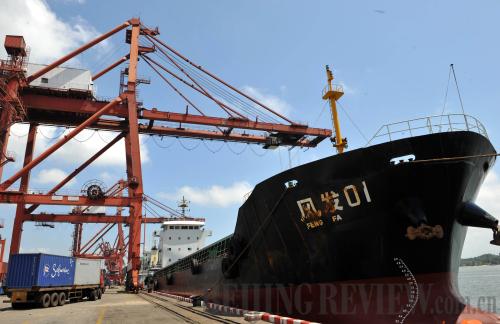|
 |
|
SEA TRANSPORTATION: Containers are unloaded from a ship docked at the Fangchenggang Port, Guangxi Zhuang (ZHOU HUA) |
As the only region sharing both maritime and land borders with Southeast Asian countries , south China's Guangxi Zhuang Autonomous Region has come to the forefront of the country's opening up to the Association of Southeast Asian Nations (ASEAN).
ASEAN has been Guangxi's largest trade partner for 14 years. According to local customs, Guangxi's trade with ASEAN countries reached $15.9 billion in 2013.
Facing the Beibu Gulf in the south, Guangxi is also home to the Pan-Beibu Gulf Economic Cooperation Forum, an emerging sub-regional platform under the China-ASEAN cooperation framework.
Held in Nanning, capital of Guangxi, on May 15, the eighth forum attracted more than 500 government officials, scholars and entrepreneurs from both home and the ASEAN nations to express their views on the theme of promoting Pan-Beibu Gulf cooperation. The first session of the forum was convened on July 20, 2006, at which the Pan-Beibu Gulf Economic Cooperation Zone, covering China and ASEAN countries, was constructed to expand and deepen China-ASEAN strategic partnership.
In the past two decades, China has grown into ASEAN's largest trade partner. In 2013, bilateral trade reached $443.61 billion, six-fold as much as that in 2003, signifying the release of huge market potentials.
Jiang Zhenghua, former Vice Chairman of the Standing Committee of the Ninth National People's Congress, said at the forum that Pan-Beibu Gulf economic cooperation will serve the urgent need to improve the China-ASEAN Free Trade Area.
"Now, the world economic pattern is going through profound and complicated changes, while the Asia-Pacific region is playing an increasingly significant role in economic development. Interconnected by the sea, countries all over the world are conducting closer exchanges in terms of trade, technology and information. Without a doubt, a new era of marine cooperation and development has arrived," said Jiang.
Areas of cooperation
One challenge ASEAN countries face is the lack of financing channels for infrastructure construction. At the forum, experts unanimously called for the establishment of a new financing mechanism to mobilize resources.
Xue Hong, Vice President of the Guangdong Branch of the Export-Import Bank of China, held that a financial system for infrastructure investment in the China-ASEAN region will push the development of harbor industries and the marine economy and then elevate the core competitiveness of related countries.
In ASEAN, non-bank financing activities are rare. Since the breakout of the Asian financial crisis in 1997, there has been no regional financial framework. The huge infrastructure investment will provide a favorable environment for securities issuance, noted Tan Khee Giap, a professor from the University of Singapore.
Tan said if China takes a lead in setting up the planned Asia Infrastructure Investment Bank, ASEAN countries will have its financing gap narrowed with long-term, low-cost funds.
In addition to financial cooperation, focus should also be laid on port and logistical partnership. Wang Zhixian, Deputy General Manager of China Merchants Holdings (International) Co., suggested that the region, with rapid economic growth, is in urgent need of a more efficient logistical and transportation network.
| 